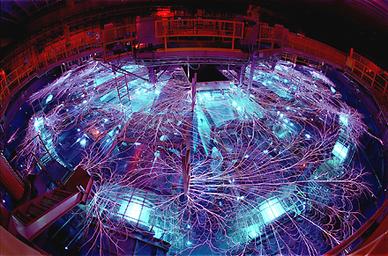20070628
analemma over ukraine
eclipsed to death by
...and you will know us by the trail of dead
@
28.6.07
1 eclipses
![]()
20070626
z machine
eclipsed to death by
...and you will know us by the trail of dead
@
26.6.07
0
eclipses
![]()
uss iwoa
 (click for full view)
(click for full view) USS Iowa (BB-61), the lead ship of the U.S. Navy's last class of battleship, was the fourth ship of the same name to serve in the United States Navy, but the second to be commissioned, to be named in honor of the 29th state.
Iowa's keel was laid down on 27 June 1940 at the New York Navy Yard. Nicknamed "The Big Stick," the battleship was launched on 27 August 1942 sponsored by Ilo Wallace (wife of Vice President Henry Wallace), and commissioned on 22 February 1943 with Capt. John L. McCrea in command.
Iowa earned nine battle stars for World War II service and two for Korean War service.
Status:
Maintained as part of the US Reserve FleetSlated to be donated for use as a museum ship on or around 2008
eclipsed to death by
...and you will know us by the trail of dead
@
26.6.07
0
eclipses
![]()
tags: battleship, fire display, military, usa
20070624
LGM-118A Peacekeeper

Picture: Testing at the Kwajalein Atoll of the Peacekeeper re-entry vehicles, all eight fired from only one missile. With live warheads, each line would represent the explosive power of twenty-five Hiroshima-sized (Little Boy) weapons.
The LGM-118A Peacekeeper was a land-based ICBM deployed by the United States starting in 1986. Under the START II treaty, which never entered into force, the missile was to be removed from the U.S. nuclear arsenal in 2005, leaving the LGM-30 Minuteman as the only type of land-based ICBM in the U.S. arsenal. In spite of the demise of START II, the last of the LGM-118A "Peacekeeper" ICBMs were decommissioned on September 19, 2005.
The Peacekeeper was a MIRVed missile; each rocket could carry up to 10 re-entry vehicles armed with a 300-kiloton W87 warhead/MK-21 RVs (twenty-five times the power of the bomb dropped on Hiroshima during World War II).
 LGM-118A Peacekeeper
LGM-118A PeacekeeperContractors:
Boeing, Martin Marietta, TRW and Denver Aerospace
Power:
First Stage: 500,000 lbf (2.2 MN thrust) Thiokol SR118 solid fuel motor;
Second Stage: Aerojet General SR119 solid fuel motor;
Third Stage: Hercules SR120 solid fuel motor,
Fourth Stage: Rocketdyne restartable liquid fuel motor; storable hypergolic fuel
Length: 71 ft 6 in (21.8 m)
Diameter: 7 ft 7 in (2.3 m)
Mass: 193,500 lb (87.75 metric tons)
Range: 9700-11300 km
Guidance: Inertial (AIRS), 393 ft 7 in (120 m) CEP
Payload: 8,708 lb (3950 kg), up to 10 Avco Mk-21 re-entry vehicles each carrying a 300KT (1.25 PJ) W87 warhead.
eclipsed to death by
...and you will know us by the trail of dead
@
24.6.07
0
eclipses
![]()
tags: boeing, missile, peacekeeper, warhead
20070621
helix nebula
The nebula, located about 700 light-years away in the constellation Aquarius, belongs to a class of objects called planetary nebulae. Discovered in the 18th century, these colorful beauties were named for their resemblance to gas-giant planets like Jupiter.
Planetary nebulae are the remains of stars that once looked a lot like our sun. When sun-like stars die, they puff out their outer gaseous layers. These layers are heated by the hot core of the dead star, called a white dwarf, and shine with infrared and visible colors. Our own sun will blossom into a planetary nebula when it dies in about five billion years.
In Spitzer's infrared view of the Helix nebula, the eye looks more like that of a green monster's. Infrared light from the outer gaseous layers is represented in blues and greens. The white dwarf is visible as a tiny white dot in the center of the picture. The red color in the middle of the eye denotes the final layers of gas blown out when the star died.
The brighter red circle in the very center is the glow of a dusty disk circling the white dwarf (the disk itself is too small to be resolved). This dust, discovered by Spitzer's infrared heat-seeking vision, was most likely kicked up by comets that survived the death of their star. Before the star died, its comets and possibly planets would have orbited the star in an orderly fashion. But when the star blew off its outer layers, the icy bodies and outer planets would have been tossed about and into each other, resulting in an ongoing cosmic dust storm. Any inner planets in the system would have burned up or been swallowed as their dying star expanded.
So far, the Helix nebula is one of only a few dead-star systems in which evidence for comet survivors has been found.This image is made up of data from Spitzer's infrared array camera and multiband imaging photometer. Blue shows infrared light of 3.6 to 4.5 microns; green shows infrared light of 5.8 to 8 microns; and red shows infrared light of 24 microns.
eclipsed to death by
...and you will know us by the trail of dead
@
21.6.07
0
eclipses
![]()
tags: helix, nasa, nebula, space telescope
eclipse
(from: Astronomy picture of the day)
eclipsed to death by
...and you will know us by the trail of dead
@
21.6.07
0
eclipses
![]()
tags: earth, eclipse, eclipsed earth, jupiter, moon, saturn, space, sun







